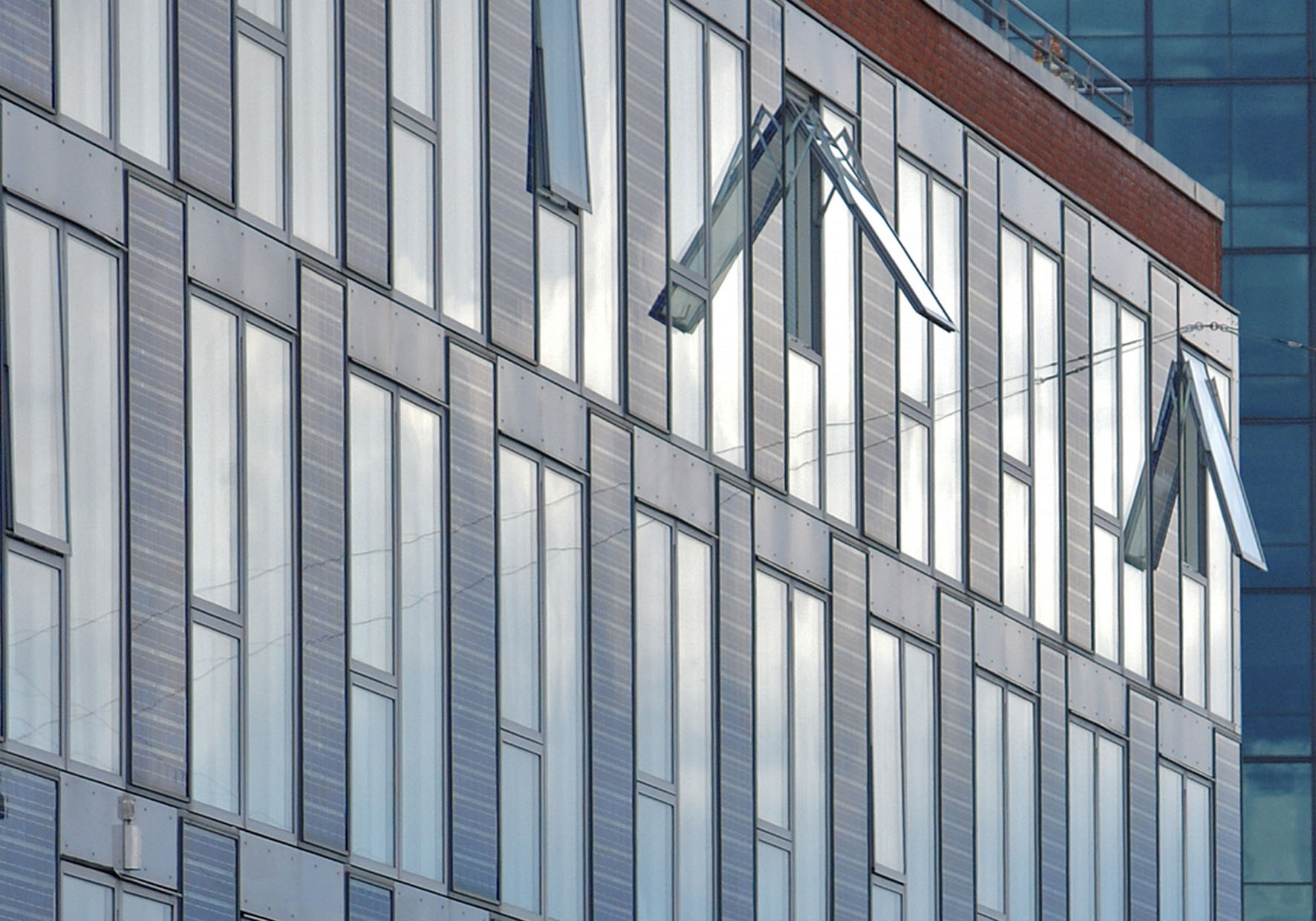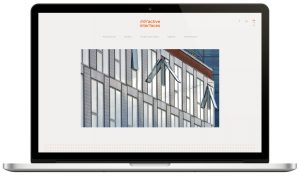
Stratégies opérationnelles permettant de dépasser les obstacles actuels à une large intégration quantitative et qualitative du BIPV aux processus de renouvellement urbain.
Ce projet de recherche contribue à la nouvelle «Stratégie énergétique 2050» de la Confédération qui requiert 10 GW d’énergie photovoltaïque (PV). A travers une approche holistique, le projet propose des stratégies concrètes afin de dépasser les obstacles à une large intégration quantitative et qualitative des systèmes photovoltaïques intégrés aux bâtiments (BIPV) lors des processus de renouvellement urbain. A l’heure actuelle, malgré les progrès technologiques et économiques, seul un faible pourcentage du potentiel solaire électrique est valorisé par des systèmes BIPV (éléments de façade ou de toiture).
Le projet de recherche fait l’analyse des diverses barrières qui tendent à limiter l’implémentation massive de BIPV aux échelles architecturale et urbaine. Il fait aussi la proposition de solutions alternatives développées au travers d’approches holistiques liées à la production industrielle, aux contraintes constructives et légales, à la qualité architecturale et aux aspects socioculturels. Dans une optique de durabilité, les nouvelles solutions proposées prennent en considération une liste étendue de critères (confort, énergie, ACV, coûts, esthétique, prix de l’électricité et connexion au réseau). L’élaboration d’études de cas réelles, réalisées sur des sites représentatifs, permet d’établir une continuité entre le développement d’éléments industriels et la génération de connaissances opérationnelles directement intégrées aux stratégies de design adaptées et innovantes.
Partenaires du projet
Laboratoire d’architecture et technologies durables (LAST), PV-LAB, LIPID, CSEM, ISAAAC (SUPSI), CC EASE (HSLU), IBI (ETHZ), IWÖ (FHSG), IEnergy (EIA-FR), econcept AG.
Equipe de recherche LAST
Prof. Emmanuel Rey, Dr. Sophie Lufkin, Dr. Sergi Aguacil
Financement
Fonds national suisse de la recherche scientifique (FNS) – Programme National de Recherche PNR 70
Site web

Thèses
Architectural Design Strategies for Building-Integrated Photovoltaics in residential building renovation processes
S. Aguacil Moreno / E. Rey (Dir.)
Lausanne, EPFL, 2019. Urban planning support based on the photovoltaic potential of buildings: a multi-scenario ranking system
G. Peronato / M. Andersen; E. Rey (Dir.)
Lausanne, EPFL, 2019. Principales publications
Evaluation of a Portable fMRI Compatible Robotic Wrist Interface
I. Farkhatdinov; A. Garnier; T. Arichi; H. Bleuler; E. Burdet
2022. 44th Annual International Conference of the IEEE Engineering in Medicine and Biology Society, Glasgow, UK, 2022-07-11 – 2022-07-15. DOI : 10.1109/EMBC48229.2022.9871667. Molecular scale description of interfacial mass transfer in phase separated aqueous secondary organic aerosol
M. Lbadaoui-Darvas; S. Takahama; A. Nenes
Atmospheric Chemistry And Physics. 2021. Vol. 21, num. 23, p. 17687 – 17714. DOI : 10.5194/acp-21-17687-2021. Accelerating the Design of Photocatalytic Surfaces for Antimicrobial Application: Machine Learning Based on a Sparse Dataset
H. Park; E. T. Bentria; S. Rtimi; A. Arredouani; H. Bensmail et al.
Catalysts. 2021. Vol. 11, num. 8, p. 1001. DOI : 10.3390/catal11081001. Characterizing the Reserve Provision Capability Area of Active Distribution Networks: A Linear Robust Optimization Method
M. Kalantar Neyestanaki; F. Sossan; M. Bozorg; R. Cherkaoui
IEEE Transactions on Smart Grid. 2021. Vol. 11, num. 3, p. 2464 – 2475. DOI : 10.1109/TSG.2019.2956152. Phonon-Ion Interactions: Designing Ion Mobility Based on Lattice Dynamics
S. Muy; R. Schlem; Y. Shao-Horn; W. G. Zeier
Advanced Energy Materials. 2021. p. 2002787. DOI : 10.1002/aenm.202002787. Exploring the Robustness of Building-Integrated Photovoltaics Renovation Scenarios to Climate Change Perspectives: Results for a multi-family building in the Swiss context
S. Aguacil Moreno; É. Nault; E. Rey
2020. 35th Passive and Low Energy Architecture PLEA 2020 Conference, La Coruña, Galicia, Spain, September 1-3, 2020. p. 1233 – 1238. DOI : 10.17979/spudc/9788497497947. Active surfaces selection method for building-integrated photovoltaics (BIPV) in renovation projects based on self-consumption and self-sufficiency
S. Aguacil Moreno; S. Lufkin; E. Rey
Energy & Buildings. 2019. Vol. 193, p. 15 – 28. DOI : 10.1016/j.enbuild.2019.03.035. Influence of design‐decisions on the energy performance of renovation projects with building‐integrated photovoltaics: Results for a 1968 residential archetype in Neuchâtel (Switzerland)
S. Aguacil Moreno; S. Lufkin; E. Rey
2018. PLEA 2018: Smart and Healthy Within the Two-Degree Limit, Hong-Kong, China, December 10-12, 2018. p. 598 – 603. Assessment of the Building‐Integrated Photovoltaic potential in urban renewal processes in the Swiss context: Complementarity of urban‐ and architectural‐scale analyses
S. Aguacil Moreno; G. Peronato; M. Andersen; E. Rey
2018. PLEA 2018: Smart and Healthy Within the Two-Degree Limit, Hong-Kong, China, December 10-12, 2018. p. 347 – 352. Assessing the photovoltaic potential of flat roofs: Insights from the analysis of optimised array arrangements
G. Peronato; S. Aguacil Moreno; A. Legrain; E. Rey; M. Andersen
2018. PLEA 2018: Smart and Healthy Within the Two-Degree Limit, Hong-Kong, China, December 10-12, 2018. p. 1032 – 1033. 3D model discretization in assessing urban solar potential: the effect of grid spacing on predicted solar irradiation
G. Peronato; E. Rey; M. Andersen
Solar Energy. 2018. Vol. 176, p. 334 – 349. DOI : 10.1016/j.solener.2018.10.011. A toolkit for multi-scale mapping of the solar energy-generation potential of buildings in urban environments under uncertainty
G. Peronato; P. Rastogi; E. Rey; M. Andersen
Solar Energy. 2018. Vol. 173, p. 861 – 874. DOI : 10.1016/j.solener.2018.08.017. Application of the cost-optimal methodology to urban renewal projects at the territorial scale based on statistical data—A case study in Spain
S. Aguacil Moreno; S. Lufkin; E. Rey; A. Cuchi
Energy and Buildings. 2017. Vol. 144, p. 42 – 60. DOI : 10.1016/j.enbuild.2017.03.047. Plug&Play brain-computer interfaces for effective active and assisted living control
N. Mora; I. De Munari; P. Ciampolini; J. d. R. Millán
Medical and Biological Engineering and Computing. 2017. Vol. 55, num. 8, p. 1339 – 1352. DOI : 10.1007/s11517-016-1596-4. Integrated design strategies for renovation projects with Building-Integrated Photovoltaics towards Low-Carbon Buildings: Two comparative case studies in Neuchâtel (Switzerland)
S. Aguacil Moreno; S. Lufkin; E. Rey
2017. PLEA 2017 Edinburgh – Design to Thrive, Edinburgh, UK, July 3-5, 2017. Influence of energy-use scenarios in Life-Cycle Analysis of renovation projects with Building-Integrated Photovoltaics – Investigation through two case studies in Neuchâtel (Switzerland)
S. Aguacil Moreno; S. Lufkin; E. Rey
2017. International Conference for Sustainable Design of the Built Environment 2017, London, UK, December 20-21, 2017. p. 1101 – 1112. Potentiel solaire des territoires urbains : vers de nouveaux paradigmes ?
E. Rey
2017. Forum Ecoparc 2017, Microcity, Neuchâtel, Suisse, September 8, 2017. p. 3 – 5.

